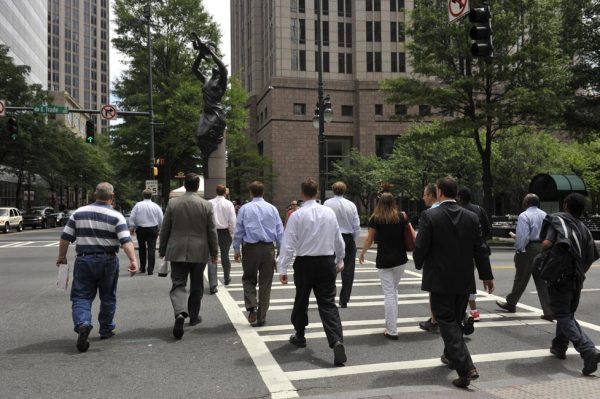Charlotte eyes stronger pedestrian policies

Charlotte’s transportation department is launching – again – an initiative to highlight pedestrian needs and improve policies for walkability. The new energy comes after the city landed on some not-so-flattering lists in the past year.
In May, the Dangerous by Design report from the National Complete Streets Coalition and Smart Growth America ranked the Charlotte-Concord-Gastonia metro the nation’s 10th most dangerous metro region for pedestrians. (See “Charlotte ranked 10th most dangerous metro for pedestrians.”) And a year ago, the national walkability rating system Walk Score®, in its 2014 report, rated Charlotte the worst large U.S. city. (See “Charlotte trails nation in walkability rankings.”)
“I don’t have to tell you how important it is creating a better walking environment here,” Charlotte Transportation Director Danny Pleasant said Monday at a City Council committee meeting. “To be a competitive 21st-century city, you have to be walkable, or at least have walkable places.”
The biggest challenge, said Charlotte Department of Transportation pedestrian program manager Scott Curry, is the city’s auto-oriented development legacy. Huge parts of the city developed during the last half of the 20th century, when pedestrian, bicycle and mass transit needs were seldom considered in the city. Transportation policy was to move as many cars as quickly as possible.
The council’s Transportation and Planning Committee was scheduled to hear a presentation Monday from Curry, but the meeting began late and Curry’s presentation was postponed until Dec. 8. But he answered PlanCharlotte’s questions about his presentation.
The initiative is called “Charlotte WALKS.” Part of its goal, Pleasant said, is to create a shared vocabulary and then adopt policies to support pedestrian needs. “The community is so ready for this,” he said.
In 2008 CDOT created a draft of a pedestrian plan but never pushed it beyond that stage. Pleasant and others have said the department decided at the time to concentrate on revising city ordinances to better support the city’s 2006 Transportation Action Plan (updated in 2011) and its then-new Urban Street Design Guidelines, adopted in 2007. The street design guidelines aim to make many city streets more welcoming to people on foot and bicycles as well as in autos.
It took until December 2010 for the City Council to adopt those changes to the city’s subdivision ordinance, tree ordinance and land development standards manual.
The “Charlotte WALKS” strategy will make the point that walkability requires more than just sidewalks, although they’re important. Curry’s presentation points to the need for a walking environment to be useful (with a variety of destinations easily accessible), safe and inviting.
Curry said an interdepartmental city team, led by CDOT and Planning Department staffers, has looked through existing city policies and initiatives to see where improvements might be needed. The group emerged with something like 18 recommendations, he said. A preliminary set of recommendations he’ll present to the council committee are:
- Safer and more frequent pedestrian crossings.
- Replacing back-of-curb sidewalks along busy streets.
- Reviewing the regulations for sidewalk construction in new development.